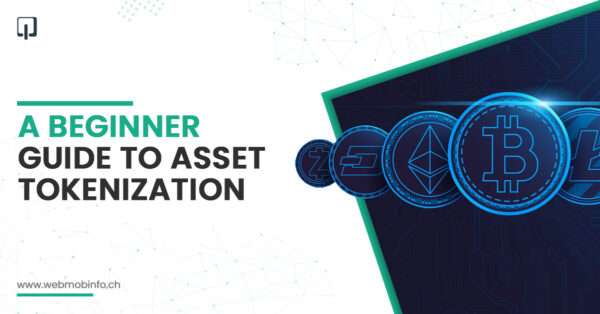Did you know that the demand for real-world asset tokenization has skyrocketed post-pandemic? In fact, this transformative trend has redefined the meaning of asset ownership and introduced the concept of fragmented asset ownership.
Table of Contents
Before proceeding further, let’s have a look at interesting facts & figures of the Asset Tokenization industry:
Market Value:
- The total market value of tokenized assets is expected to exceed USD 10 trillion by 2030 significantly.
- In a more conservative estimate, the market for tokenized assets could reach $3.5 trillion.
Current Market Size:
- As of Q4 2020, the global asset tokenization market size was USD 18.1 billion.
- The global tokenisation market was valued at $2.3 billion in 2021 and is projected to reach $5.6 billion by the end of 2026.
- Additionally, the market is expected to expand at a compound annual growth rate (CAGR) of 24.09% from 2022 to 2030.
What is Asset Tokenization?
In layperson’s terms, asset tokenization converts physical and non-physical assets into digital tokens using distributed ledger technology, such as blockchain.
The concept is straightforward: You take an asset, tokenize it, and then distribute these tokens to investors. Each token represents fractional asset ownership, making it easier to trade.
So, the question is, how is asset tokenization in blockchain beneficial for investors?
Imagine it is similar to owning a piece of real estate, a work of art, or even shares in a company. However, instead of traditional ownership documents, you hold digital tokens representing your asset’s stake. Furthermore, you can trade these tokens on the blockchain platform for a significant share gain.
Tokenization of Assets: Real World Asset Tokenization
Real-world assets (RWAs) are tokenized on blockchain technology for conventional and tangible financial assets like cash, commodities, stocks, bonds, credit, artwork, and intellectual property. The ability to access, trade, and manage RWAs has changed significantly with their tokenization. The asset tokenization sector has opened up new possibilities for blockchain-powered financial services and a broad range of non-financial use cases supported by decentralized consensus and cryptography.
Asset tokenization has been one of the most promising use cases for blockchain technology, with a market cap encompassing nearly every global economic activity. Now, most crypto enthusiasts believe that the future of finance lies on the blockchain and that almost every real-world asset will be featured on it. To achieve that, all tokenized entities should be on the blockchain connected by a universal interoperability standard.
Which physical items can be considered for Real-World Asset Tokenization?
Let’s see:
- Real estate: Tokenizing properties enables investors to purchase portions of a building or piece of land without acquiring the entire asset.
- Art and Collectibles: Several investors can own some of them by tokenizing valuable artwork and collectables.
- Commodities: Tokenizing assets such as gold, oil, and other commodities can make trading more accessible and practical.
- Equities: Tokenising a company’s shares gives you access to more flexible and accessible investing options.
How Tokenization of Real-World Assets Works?
The process is quite simple. It involves creating a digital representation of the physical asset, uploading its details to the blockchain and ownership details, and then creating fragmented digital asset tokens.
Here’s a simplified version of the process:
- Choose the Resource: Decide which tangible asset should be tokenized.
- Indicate the Token: Choose the token standard (ERC20 or ERC721), the kind of token (fungible or non-fungible), and other essential token attributes.
- Select the Blockchain: Choose between a public and private blockchain network to issue the tokens. Use Chainlink Cross-Chain Interoperability Protocol (CCIP) integration to guarantee that the tokenized asset may be accessed on different blockchains.
- Link Off Chain Data: Utilise top-notch off-chain data from dependable and safe Chainlink oracles. To ensure user transparency, employ a verification tool such as Chainlink Proof of Reserve (PoR) to verify the assets that support the tokens.
- Distribute the tokens: Mint the tokens and make them accessible after deploying the smart contracts on the chosen network.
Benefits of Asset Tokenization
Tokenized assets offer enhanced liquidity, greater access, transparent on-chain management, and reduced transactional friction compared to traditional assets. For financial assets, tokenizing real-world assets (RWAs) consolidates a single layer of distribution, trading, clearing, settlement, and safekeeping. This creates a more streamlined on-chain financial system, decreases counterparty risk, and allows for more efficient capital mobilisation.
Here’s a broader aspect of the benefit of RWA:
1. Liquidity
Assets that have historically been illiquid may become more liquid through tokenization. Liquidity is increased by dividing assets into smaller, tradable tokens, making acquiring and selling parts of the asset easier.
2. Fractional Ownership
The potential to provide fractional ownership is one of the most beneficial features of tokenization. This implies that you can purchase a portion of the asset rather than the complete one. As a result, investors have a reduced entry barrier and can create more diversified portfolios.
3. Accessibility
Access to investing opportunities can be made more democratic through tokenization. It makes it possible for investors from all over the world to purchase properties that were previously unattainable because of financial or geographical limitations.
4. Security
Blockchain technology provides strong security characteristics. Every transaction is documented on an open, transparent, and decentralised ledger. This, or the tokenization blockchain, lowers the possibility of fraud and guarantees the accuracy of ownership data.
5. Economical
Tokenization can lower transaction costs by doing away with intermediaries and simplifying the purchase and sale of assets. For both buyers and sellers, this improves the process’ overall effectiveness and economy.
Real-World Assets in DeFi
Tokenized assets and DeFi are directly and fundamentally related. DeFi, the top technology layer to support financial activities, is a proof of concept for on-chain financing.
In DeFi, tokenized RWAs are becoming increasingly popular. DefiLlama estimates that as of December 2023, the total value locked (TVL) in RWAs was close to $5 billion. Tokenizing real-world assets also makes innovative financial products possible. One of TVL’s most important DeFi protocols, MakerDAO, for example, backs the stablecoin DAI with various real-world assets. This method creates new financial assets by combining blockchain-based and traditional assets and technologies.
WebMob’s Role in Real-World Asset Tokenization
WebMob Software Solutions has been a decade-long industry player providing robust solutions for tokenizing real-world assets. Thanks to our vast experience, we have created cutting-edge methods and tools for tokenizing various assets, such as stocks, commodities, real estate, and artwork. We are aware of this procedure’s difficulties and have designed our solutions to handle the unique challenges presented by each asset class specifically.
One of our significant contributions has been developing safe and effective tokenization platforms that abide by legal requirements and guarantee investor transparency. By combining state-of-the-art blockchain technology with smart contract solutions, we have made it easier to issue, trade, and manage tokenized assets.
After the tokenized RWAs are enhanced with real-world data, they must be able to be transferred between blockchains while maintaining their current state of information about price, identity, and reserve value. Therefore, a secure solution that provides off-chain and cross-chain connections is required for a wide range of public and private blockchains. Our team resolves this issue by offering complimentary services, including cross-chain and off-chain data communication, while upholding the strict security standards that financial markets and institutions demand.
Takeaway
The tokenization of the real-world asset market is a significant development with enormous potential to change the financial system. Switching to an on-chain approach creates new possibilities for investing and money management.
Blockchain-based systems, as opposed to conventional financial infrastructure, solve fundamental problems like accessibility, security, and transparency, opening the door for a more effective and equitable financial ecosystem. Tokenization has the potential to completely transform how we engage with and invest in assets, opening up previously unheard-of levels of liquidity and democratizing access to wealth creation as it continues to gain momentum.
Nitin Gupta, the CEO of WebMob Software Solutions, is a visionary leader renowned for his innovative approaches to leveraging emerging technologies to transform businesses globally. Under Nitin's guidance, WebMob has evolved into a pioneer in fintech, catering to esteemed clients across Europe, APAC, and the Middle East. As a thought leader, he continues to drive WebMob towards new heights of success, cementing its reputation as an industry leader in the IT sector.

